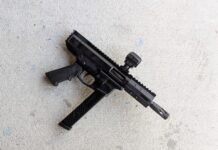I haven’t shared a Sage Dynamics video in awhile and the data Aaron puts out is relevant to a bunch of interests, to include my own. So we are correcting that with the Romeo 2 review.
As many know, the Romeo 1 (not the Pro) was a less than spectacular addition in its earlier iterations of red dot optics on the market. It caused a lot of consternation in the Sig super fan camps and caused a lot of feelings of vindication in the Sig hater camps. Biases confirmed in what manner or another, what is the internet for if not for confirmation bias?
Anyway, the nuts and bolts of the situation was that Sig’s Electro-Optic division learned. They received a bunch of good data form these tests and these broken sights. They used that data and implemented a quick fix and a long improvement. The quick fixes resulted in the Pro model of the Romeo 1. An optic much improved and one I am currently carrying EDC on my P229. Is it my absolute favorite dot? No, but it is serviceable and I see no reason to swap to my preference of 508T at this moment.
The long improvement has been the Romeo 2. Like LPVOs, dots have been on an upgrade trend as we see shooters pick and settle on feature balance to get what they want out of their sights.
The Romeo 2 is the first optional open/closed emitter optic I am aware of. It offers unshrouded, partial shroud, and full shroud with lens options to cut down on small debris intrusion and other impediments with the optic. Battery access and control scheme also have upgrades. About the only thing the Romeo 2 has that is potentially problematic is a modified footprint. It’s still DPP real estate, but without the front lugs so plates will be necessary. Plates are normal in the dot life nowadays though, so that amounts to just more of the same.
What I find most interesting is the ‘build your own’ option the Romeo 2 has brought to the table. Open or closed at preference. You can reconfigure based on environment. For regular EDC you may go shroudless, or the partial options, while in the winter or going to a wetter and/or dirtier environment you might seal it up. This allows from some exceptional used flexibility without remounting and will allow maintenance for damage to the more easily replaceable parts (the shroud and rear lens) should they take enough damage to warrant it.
I don’t know if this signals a trend in optics as configurable. I don’t think so.
Configurable is great in theory, it is even good in practice when executed properly. But we’ve seen that most users want to have a single simplified solution when it comes to their carbines, and I believe that trend is going to continue with optics. We, despite the costs, will trend toward having two guns with dedicated optical systems rather than one gun with a configurable one. Users like a solution they can pick up. We saw this in AR’s and the theory of the swappable upper. That theory, when exercised well, holds a lot of merit for flexible capabilities. But users overwhelmingly have shied away from modular use, not modular capability but modular use in practice, and have trended towards dedicated complete systems.
Can you use the same lower to run a CQB optimized SBR and an accuracy optimized Designated Marksman rifle? Absolutely. Our years long practical implementation study has shown us that users will end up with two rifles, not a single receiver and multiple uppers. It is human preference, less steps to use. So despite the cost and practical benefits it is most likely that a user will end up with two pistols, even if they are the same pistol, and that both those pistols will be running a different optical configuration… even if both optics are Romeo 2’s. People are interesting that way.
Now, preferences and configurations for something like a department? Different story with a dedicated armorer or method of maintenance. There could easily be a summer carry/winter carry policy or update set into motion. That’s where capabilities like this can prove out. For the most part I see the capability as a build it and leave it, you’ll pick the configuration. For something like the M17/M18 that could be deployed to a variety of climes and places it could also prove useful.
Time will tell. It looks to be a well executed concept.



